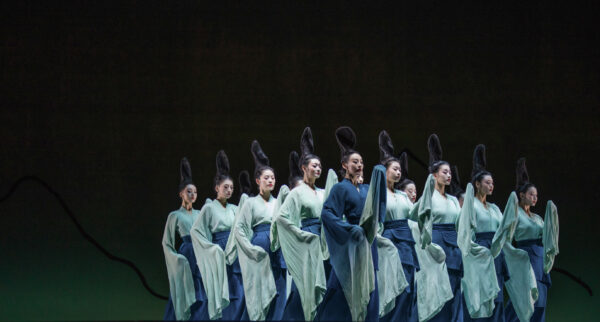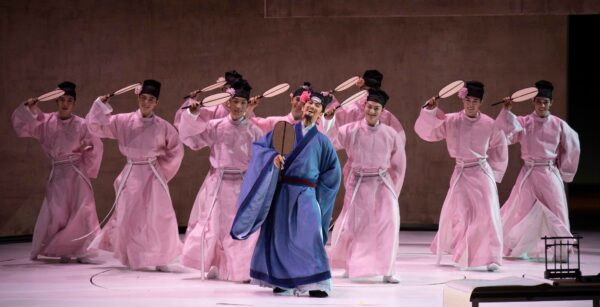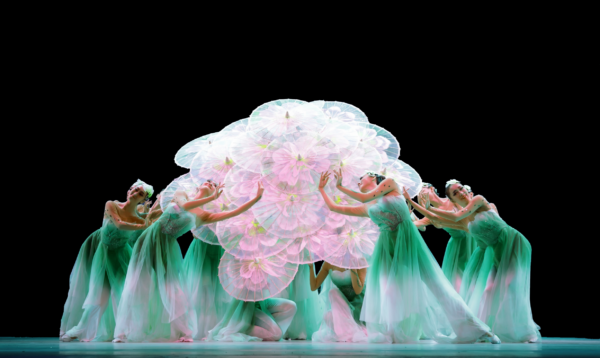Southern California hosts one of the largest Sino diaspora communities in the United States. Approximately 4% of the population—over 5,000 first-generation immigrants—centers around the 626 Asians, a celebrated food haven in the San Gabriel Valley (area code: 626) for authentic Chinese regional cuisine. Angelenos, fortunate to enjoy a diverse cultural landscape, have developed a taste for the food, arts, and traditions of the Far East. Dance of Oriental, an evening gala program that spans folk traditions, classical dance, and contemporary reimaginings of Chinese culture, performed by the China Oriental Performing Arts Group (COPAG) and presented by Oever, LLC, promised a unique spectacle. Unlike typical community performances, this professional troupe of classically trained Chinese dancers offered an alternative to the usual Nutcracker ballets, marking the start of the Lunar New Year season in January.
The evening’s presentation on Jan. 4 at the Dorothy Chandler Pavilion in Los Angeles, however, feels uneven. If this performance represents the pinnacle of Chinese cultural art on the international stage, there remains significant room for growth. Compared to similar groups such as Japan’s KODO Taiko drummers, COPAG’s offering occasionally appears amateurish and overly gaudy—bordering on cheap. While acknowledging the differences in cultural aesthetics and traditions between Japan and China, Chief Director Xie Yuanzhen might benefit from exploring how to elevate this art form with broader international appeal.
The presentation falters further due to poor translation from Mandarin to English and awkwardly worded introductions for each dance number. The bilingual format, while understandable, often feels more like a school assembly than a polished professional production. Having grown up with similar performances on Chinese Central TV, I find this stiff and outdated format disappointing.
That said, the evening was not without its highlights. The dancers are undeniably talented, and moments of grace and artistry shine through the busy, Wagnerian orchestrations, garish projections, and Spirit Halloween-esque costumes. Numbers like “Jasmine,” “Chinese Treatment,” and “Dance of the Peacock” feel more like caricatures of Chinese culture than thoughtful interpretations. The imperfections in staging, minute errors, and subpar production culminate in a lackluster performance, particularly in the climactic “Flying Apsaras.”
Yet, one performance turns the night around: Yang Han’s solo in “Dance Gabe” (Fish). His androgynous costume, paired with acrobatic and expressive movements, lifts the atmosphere and re-engages the audience. Following this, two excerpts from the internationally acclaimed dance drama The Journey of a Legendary Landscape Painting—”Green and Imperial Academy of Painting”—stand out as the evening’s highlights (The Journey of a Legendary Landscape Painting will appear in its entirety at Lincoln Center Jan. 10-12). The narrative focus sharpens, and the staging and execution rise to a higher level. These pieces showcase the troupe’s potential, with well-rehearsed dancers, immaculate staging, and richly constructed costumes. The interplay of lush pinks in the male ensemble and radiant greens in the female ensemble evokes the aesthetic and philosophical beauty of Song Dynasty art.
In “Green,” the ensemble and soloist present a visual exploration of Song philosophy through color, movement, and form. The fluid, precise choreography creates an otherworldly experience that defies description—a true embodiment of artistic transcendence.
Unfortunately, Lyu Liang‘s music direction is less effective overall. While the East-West fusion of Chinese instruments with Western orchestration intrigues, the lack of traditional Chinese instruments or live music is a glaring omission. It raises the question: Is there hesitation to fully embrace Sino-cultural elements? A live ensemble would have added depth and authenticity, which the performance sorely lacks.
I sincerely hope the China Oriental Song and Dance Troupe returns to Los Angeles. Their presence enriches the Chinese diasporic community and fosters vital cultural exchange between the U.S. and China—an essential endeavor in today’s world. However, Los Angeles audiences deserve a performance that better represents the depth and beauty of Chinese culture.
photos of China Oriental Performing Arts Group (COPAG), courtesy COPAG
Dance of Oriental
China Oriental Performing Arts Group (COPAG)
presented by Oever, LLC
part of the inaugural 2025 Arts and Cultural Season and Cultural Heritage Festival
reviewed on January 4, 2025, at Chandler Pavilion in L.A.
for more events, visit Oever
next from COPAG at David H. Koch Theater, Lincoln Center, NYC
January 10 to 12, 2025 Poetic Dance: The Journey of a Legendary Landscape Painting
January 17 and 18, 2025 Westward Spread of Eastern Opera,
a contemporary interpretation of Peking Opera



